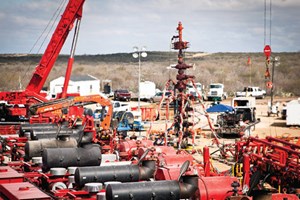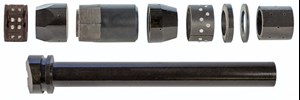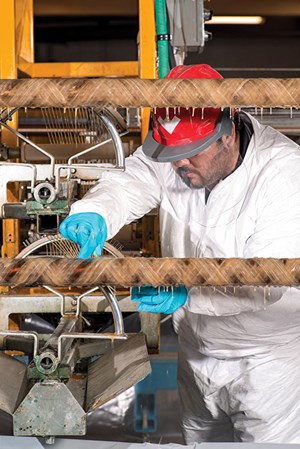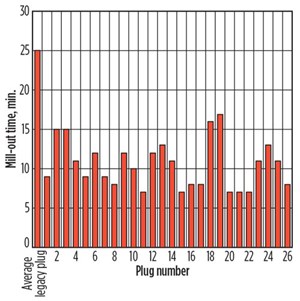Composite plug advances accelerate plug-and-perf operations

The past decade has seen a resurgence in U.S. oil and gas production, led by the rapid development of shale plays across the country. The dual technological advancements in horizontal drilling and hydraulic fracturing have been largely responsible for turning shale reservoirs from inaccessible source rock to profitable production targets.
By some industry estimates, hydraulic fracturing is used on approximately 90% of all newly completed wells within the U.S., and interest is growing around the globe. The majority of these wells (more than 80% by some estimates) employ the “plug-and-perf” method of multi-zone fracturing, in which composite plugs are pumped downhole and set in place to isolate zones, and ensure that simulation fluids are directed into a specific zone.
The rapid rise of shale drilling in the U.S. has slowed recently, due to the drop in global oil and gas prices. This has prompted operators to search for new methods of optimizing the development and operation of their existing assets, in ways that maximize production with minimal costs.
One area of focus within this optimization initiative has been composite frac plug design. Many frac plugs available on the market employ older designs, which can create deployment challenges in fracturing applications. A given well might require 10 to 40, or more, frac plugs to effectively isolate and stimulate individual zones in a lateral that is one mile or more in length. These plugs must be deployed quickly to their desired landing location, set properly to hold pressure reliably during the frac job, and then mill out quickly, with the smallest-sized cuttings possible.
BUILDING AN OPTIMIZED PLUG
Weatherford has developed a new-generation frac plug, that will meet these industry demands, routinely and reliably. The result, known as the TruFrac plug, is made with a proprietary blend of 97% premium composite material, that enables higher run-in speeds and more efficient milling, while providing superior sealing and anchoring during the frac job.

Development of the plug began with a blend of proprietary composite material that Weatherford has used for over a decade. Weatherford is the only major oilfield service provider that has in-house design and manufacturing capabilities for its composite plugs. An internal composite manufacturing facility, coupled with dedicated composite design engineers, allows for complete quality control of the entire supply chain and tighter control over each plug’s composition.
The individual components of the frac plug were researched, designed and optimized to perform their designated functions in the hole, and fit together into a plug that is lightweight, compact in size and able to hold a high-pressure seal, Fig. 1. The first component, an upper slip and cone, is machined from a single piece of proprietary composite and paired with powdered metal buttons. The buttons provide a robust, high-strength anchoring force into the casing string, which maintains the setting force in the plug during the operation. The buttons and easily millable, composite matrix quickly drill out into small pieces for efficient return during mill-out.

A molded element system provides a high-strength seal and smooth surface that enable run-in speeds of up to 500 ft/min. The seal is rated for a maximum pressure of 10,000 psi and temperatures up to 300°F, allowing it to be deployed in a variety of challenging downhole environments. The molded system also possesses a backup system, which ensures that the element does not extrude while holding pressure. The element has a smooth outer body devoid of any rough edges, an important design feature that minimizes the risk of the element getting hung up on ledges, wellbore debris or casing joints. A lower cone is connected to the molded element system, and is designed to interface with the proprietary lower slip system. The cone’s faceted nose design helps eliminate spinning during mill-up, Fig. 2.
Perhaps the most critical component of the plug, the lower slip provides the main anchoring force to hold the plug in place during hydraulic fracturing of the zone. Composite engineering expertise was critical in developing a lower slip, which would provide superior anchoring, with a minimal amount of metal. The slip consists of a combination of high-strength composite and small, soft cast-iron inserts. This design ensures a reliable, robust seal with the casing string during the frac job. Once the milling operation begins, the composite material of the slip and small buttons breaks up quickly for more efficient well cleaning.
A mandrel runs through the interior of the other components making up the plug and is composed of the same composite element as the upper slip, which also allows it to be milled out into small cuttings. The mandrel has a beveled mule shoe with a 45° angle on the end next to the lower slip. During mill-out, the beveled shoe acts as a clutch that locks onto the top of the next plug below it, thus preventing the plug body from spinning as it is milled, and thereby decreasing mill-out time.
The design of the mule shoe has been optimized since its initial introduction, to include a groove containing a rubber ring. This ring, known as a pump-down ring, has a slightly larger outside diameter (OD) than the plug, thus creating a larger overall OD for the entire plug assembly. An operator using this optional pump-down ring can then pump against the plug during its deployment downhole, using less water to get the plug into position and thus achieving a more efficient pumping job.
SUCCESSFUL PILOT TRIALS
The final plug design was the culmination of nearly 14 months of design and laboratory qualification work, which resulted in a shorter, lighter plug for easy and efficient deployment. At the same time, this plug would provide the necessary strength-of-seal during a frac job, and then mill out faster with fewer
large cuttings.
A number of operators had expressed interest in conducting trials of the prototype plug. Thus, once the plug was ready, field trials began immediately to put it through its paces. Over the course of six months, the field trials uncovered some design issues with the plug body that caused hang-ups in a well. Weatherford engineers pulled these plugs and conducted a thorough investigation of the root cause of the problem. Working with the internal design composite engineering group, the engineers were able to make the necessary changes to the design, thus solving the plug-related hang-up problem.
The field trials helped prove the plug’s functionality in a variety of well architectures and deployment options. It can be used in both single and stacked, multiple-zone stimulation applications, enabling flowback through the body for pressure equalization or production. The plug’s design permits deployment in vertical, deviated, horizontal or multilateral wellbores. The plug also enables underbalanced drill-out of multiple plugs to protect sensitive formations.
Available for 4½-in. and 5½-in. casing sizes, the TruFrac plug comes with the choice of internal ball fracture plug or a floating top ball. The top-ball design provides a larger flow area for higher return rates, while the internal design keeps the ball in place inside the plug. The flexibility of these tools saves operational time, while protecting sensitive formations.
The plug provides versatility in terms of deployment, and can be run on tubing, drillpipe, coiled tubing (CT) or wireline, using conventional fracture plug setting equipment. The composite material allows for rapid drill-out using conventional drilling equipment, including CT drilling motors.
The pilot trials demonstrated that the plug’s new compact design, coupled with a minimal amount of metal content and smooth OD body, helped circumvent many of the deployment and mill-out challenges common to legacy plugs.
Harnessing full hydraulic energy during run-in. Frac plugs are typically conveyed through the wellbore by the pumping action of fluids from the surface. Therefore, plug manufacturers had to walk a fine line between keeping the OD of the plug large enough to harness as much of this hydraulic energy as possible, while also avoiding the risk of having the plug prematurely set or stuck in the well.
The TruFrac plug’s smooth body and lack of rough edges or protrusions eliminates the need to make compromises on the plug OD. When deployed with a pump-down ring, the overall OD of the plug is sufficient to harness the full hydraulic energy of the pumped fluids. This technique allows for more efficient deployment, with less water and shorter run-in times.
Avoiding premature setting or sticking. Many conventional frac plugs have long body designs and may be composed of many metallic components. These heavier, longer plugs may have difficulty traversing tight bends and tortuous, long laterals without becoming lodged in the wellbore. Pulling via wireline cannot typically retrieve stuck plugs, and thus, a longer intervention operation is required. Pressure pumping operations must be halted, and the operator has to secure a workover rig, such as a CT unit, to drill out or push the plug ahead prior to resuming operations.
For plugs with highly sensitive element systems, the hydraulic pressure due to the pumping action of fluid behind the plug may trigger premature setting. Not only can premature setting of conventional plugs raise the risk of damage to the casing and jeopardize casing integrity, but it requires an intervention to drill out. Stuck and prematurely set plugs add significant time and cost to the frac job, and introduce additional debris into the well that may have to be cleaned out prior to stimulating the well.
The new plug’s smooth composite body alleviates many of the risks of sticking and premature setting by reducing the risk of rough edges getting hung up on wellbore debris or overtorqued collars. In addition, the plugs are significantly shorter and lighter than many legacy plugs in the industry today, which allows them to pass more easily through long laterals and tortuous wellpaths, and at higher speeds. While an operator might want to maintain a conventional plug’s speed at 150 ft/min. or less to avoid getting stuck, the TruFrac plugs can be run reliably in horizontal holes at rates of up to 500 ft/min. to provide significant savings in operational time.
Drilling out faster. Conventional frac plugs tend to be longer, heavier and contain more metal. This translates to longer drill-out times that increase costs associated with the rig and its crew. These plugs also generate cuttings that are heavier and larger in size, which makes their removal from the wellbore more difficult. Cuttings left in the well may plug perforations and impede fluid flows from the newly stimulated wells.

The compact nature of the new plug shortens the mill-out time considerably, and the composite material making up the bulk of the plug breaks down into lightweight cuttings, with a smaller size distribution. These cuttings lift out of the well easily and minimize the risks associated with plugging of surface equipment. The lack of wrought metal parts, such as brass or steel, in the plug also saves time and enables mill-out with conventional Tricone or junk-mill bits.
ACCELERATING EAGLE FORD OPERATIONS
The TruFrac plug’s successful track record in its six-month pilot trials convinced several shale operators to see if the plug could deliver the same efficiency improvements in their own wells. An operator in the Eagle Ford shale selected the plug to help decrease time on location during the mill-out phase of its plug-and-perf operations. First, an oil producer, completed with 5½-in., 23-lb/ft casing, had a total measured depth of 18,325 ft, a lateral length of 5,667 ft and bottomhole temperature of 285°F.
Weatherford deployed 5½-in. top-ball composite plugs in 26 zones, allowing the operator to successfully stimulate each zone. Each plug maintained a tight seal with the casing during each frac and easily withstood the 6,500-psi circulating pressure in the well.
The bottomhole assembly for mill-out of each plug consisted of a 4⅜-in., JZ 126 rock bit, 3⅛-in. mud motor, agitator, jar and 2⅜-in. high-pressure CT unit. The CT and rock bit drilled the plugs out at an average time of 10.5 min. per plug. The maximum drill-out time was 16 min. for two of the plugs and as low as 7 min. for five plugs. This time-saving was achieved without having to run any short trips to clear the wellbore of plug debris, Fig. 3.
The operator was impressed with how the short-length, low-metal-content composite plugs helped achieve its goals of reduced mill-out and on-location times, and improved overall well economics, by allowing the well to be brought onto production faster. The operator has used the new plug on subsequent fracture stimulation jobs in other wells and achieved similar results.
To date, approximately 7,000 TruFrac composite plugs have been deployed in more than 450 wells for operators throughout the U.S. Shale operators have realized consistently the plug’s dual benefits of superior sealing during a frac job and easy mill-out, post-stimulation. The reduction in on-location time and associated costs improves overall well economics. ![]()
- Shale technology: Bayesian variable pressure decline-curve analysis for shale gas wells (March 2024)
- What's new in production (February 2024)
- Prices and governmental policies combine to stymie Canadian upstream growth (February 2024)
- U.S. operators reduce activity as crude prices plunge (February 2024)
- U.S. producing gas wells increase despite low prices (February 2024)
- U.S. drilling: More of the same expected (February 2024)


